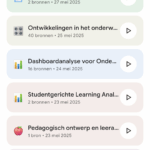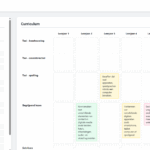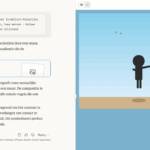Techcrunch heeft vandaag een bericht over Understoodit. Het is een nieuwe dienst die nu nog in besloten bèta is. De functie: het bieden van een anonieme mogelijkheid aan studenten om tijdens een college via hun laptop of smartphone aan te geven of ze de stof begrijpen of dat ze “verward” (confused) zijn.
Het is niet de eerste applicatie op dit gebied die ik voorbij zie komen, maar met name het filmpje bij Understoodit zorgde voor een tamelijk onaangenaam onderbuikgevoel.
Het zal deels komen door de animatie die gebruikt wordt: een docent staat voor een collegezaal met daarin silhouetten van studenten. Je hoort haar op de achtergrond murmelen. Anoniemer kan het niet worden. OK, de setting is helder.
De studenten hebben niet beters te doen dan op hun smartphone, laptop, iPad te kiezen uit twee grote knoppen “understand” of “confused”. De docent, die blijkbaar twee laptops ter beschikking heeft (of anders met een krijtbord werkt) heeft een laptop voor haar neus staan met daarop de beurskoersen: een rode lijn voor het percentage studenten dat confused is en een groene lijn voor de studenten die het nog begrijpen.
Na een tijdje ziet ze op haar grafiek dat de studenten het niet begrijpen. Ze legt het dan nog een keer uit en lo and behold, alle silhouetjes veranderen in groen. Iedereen heeft het begrepen.
Natuurlijk. Het is een animatie. Bedoelt om het principe duidelijk te maken. Maar de boodschap die ook uit de teksten op de website naar voren komt is: als jij als student maar aangeeft of je het snapt of niet, dan komt het wel goed, dan weet de docent automagisch wat te doen om dat te veranderen.
Daar geloof ik nou eenmaal niet in. Begrijpen is niet binair. Het is niet uitsluitend “wel” of “niet”.
Ik ben dan ook heel benieuwd naar de resultaten van het gebruik van weView, een applicatie die binnen Fontys ontwikkeld wordt. Hoewel ik de combinatie die daar met iPresent opgezet wordt voor een ‘gewone’ docent tamelijk complex vind, biedt het wel de mogelijkheid om meer te doen dan alleen wel of geen begrip door te geven.
Waar ik dan met name ook benieuwd naar ben is hoe de docent daar mee omgaat. Want zo’n grafiekje als in de video lijkt me al tamelijk heftig, maar als studenten je live vragen of opmerkingen door gaan sturen dan kan ook dat uit de hand lopen. Nee, niet bij compacte groepen, maar als je een collegezaal vol hebt zitten, dan zul je toch haast een studentassistent (een moderator) nodig hebben om e.e.a. in goede banen te leiden. Zoals je dat bij een online presentatie ook doet.
Hoe dan ook, ik heb me niet aangemeld voor de bèta, het zou mooi zijn als ze er ook wat gedegen onderzoek aan willen besteden dat verder gaat dan aan studenten vragen of ze het nuttig vonden dat het beschikbaar was (daar weet ik het antwoord namelijk wel op).




Hi Pierre, I read your blog using Google Translate, so I may have missed some nuances, but I think I got the gist. You’re correct that the video is a simplification of how understoodit would effect classroom learning. The goal of the video was to make it immediately clear how understoodit could be used in a classroom. You’re also correct that understanding is not binary, perhaps the video should have showed color gradients instead of red and green! The goal of understoodit is to make software that is useful for teachers and students. If you have specific ideas on how to make understoodit better feel free to email me!
Hi Liam,
Thank you for taking the time and effort to use Google Translate to read the post. I had a number of problems with the video: it shows a total lack of integration of the Understoodit tool with the material that is being covered in the course. It sort of positions the students as passive listeners that only do one thing: indicate whether they understand it or not.
And then the lecturer, by just looking at a graph of that understand/confused score magically knows what to do (“explain it again” – what would make her think that the student would understand it the second time?) to make the students understand.
The other app that I link to, weView, aims to provide students with more interaction options. Not only does the app display the current slide the lecturer is showing, it also provides students with more than just the binary option of “I understand” / “I don’t understand” option. Students can send questions or comments to the lecturer.
My worry there would be that it can become very overwhelming for the lecturer. I haven’t seen any research on use of this tool on a larger scale though (usually reports on those kind of tools are limited to small scale experiments).
One of the primary goals of understoodit is to be as simple as possible to use. We don’t want to overwhelm either the teacher or the student with features that they may not use. The confused/understood buttons are a starting point. We’re hoping to work with educators over the next few months and add features that they would find useful, while ensuring that understoodit does not become needlessly complex or distracting.
Several educators have mentioned that being able to demarcate sections of the lecture in understoodit would be useful. This may be the next feature added to understoodit – I’ll need more feedback to determine this though.
I’ve noticed that in classes with over 100 students, students would rarely be engaged and would seldom put up their hand or ask questions. I want use understoodit to help solve this problem.
In your opinion what would be the single best feature that we could add to understoodit to make it that much more useful?